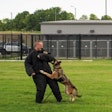Diversionary devices have had many names, not all of them popular. But that's mostly due to the public's misperception of what they are and how they are used.
Often known generically as "flash-bangs" because of the bright flash and loud noise used to distract suspects, they are sometimes seen as unnecessarily dangerous and harmful weapons. The original term "stun grenade" might have something to do with this misunderstanding. In reality, a diversionary device contains no shrapnel, so it's not a grenade, and its effects on sight and hearing are only temporary-persisting just long enough to disorient the bad guys so the good guys can make entry and carry out their mission.
"If you ask any SWAT officer or military personnel, they'd say it's a tool to accomplish a mission," says Bob O'Brien, a retired Cleveland Police Department SWAT sergeant.
O'Brien participated in approximately 500 SWAT callouts a year in his time with Cleveland PD. He's seen what diversionary devices can do, and how far they've come since the early 1980s when they were first being used by American law enforcement. While the first diversionary devices were sometimes more powerful than need be and had a tendency to skip across the floor when deployed, companies have worked out the kinks since then. Now it's not a question of whether to use them, but how often and for which type of operation.
"Some teams use them all the time," says O'Brien. "If there is a danger element involved in the operation they use a flash-bang. Other teams are more selective and only use them when they think it will benefit that specific raid."
Tactical entry teams commonly use diversionary devices for hostage rescue and drug raids. But everyone has a different philosophy on their best use.
"If you ask a dozen SWAT team members, they'd probably give you a dozen different answers on how they use them and why," says O'Brien. "In law enforcement, there are different theories. The personal one I like is 'surprise, shock, and speed.' You want to surprise your adversary, shock them so they can't really react to you, and capitalize on it by attacking with speed. Where flash-bangs fit in is you're surprising and shocking them at the same time with the use of a flash-bang, and you take advantage of it with speed."
Whatever your tactical philosophy, it's hard to deny the benefits of diverting the attention of armed and dangerous adversaries during a particularly difficult mission. It might provide the means to effect a rescue without casualties.
"The bottom line as far as I'm concerned is the diversionary device is a useful, life-saving tool," says O'Brien. "They save lives, they will save lives, they will continue doing so."
A.L.S. Technologies
Bull Shoals, Ark.-based A.L.S. Technologies sells a variety of diversionary devices, including single-use and reloadable models. The ALS4140 steel body can be reloaded with replacement fuses up to 40 times. The device can be reloaded without a cleaning kit or having to retap the threads. Manufactured utilizing CNC machinery from strong corrosion-free aluminum, this device has a large venturi port designed to permit fluid gas flow, which mitigates movement and enhances heat dissipation. A.L.S. diversionary device bodies are available in steel or aluminum. Training bodies and fuses are also available.
CTS
Combined Tactical Systems, commonly known as CTS, manufactures the model 7290 Flash-Bang as well as the 7290M Mini Flash-Bang. Energy is released radially and equally through top and base ports at an angle of 15 degrees off the vertical axis. The device remains intact and is disposable after use. Both the standard and mini are available in training models with an output of only 120db and no flash charge. The training models are reuseable and are painted a bright blue to be easily identified.
Defense Technology
Defense Technology, an Armor Holdings company, manufactures a variety of less-lethal devices, including the Multi-Port Plus distraction device. In addition to light and sound, its 15 grams of flash powder make for a greater report and pressure wave. The new MultiPort Plus body now features additional porting and decreases movement, without negatively affecting the performance of light, sound, and pressure wave. Multi-Port Plus is available with regular or safety clip reload and can be used on command from a remote point when used with available accessories.
MK Ballistics
Hollister, Calif.-based MK Ballistics is best known for less-lethal ammunition. But the company, headed by Michael Keith, also manufactures and sells a selection of distraction devices. Both standard and training models are available, as are bodies and reload charges for reuseable models. Strategically positioned porting ensures efficient heat dissipation and minimum movement after each device is deployed.


















